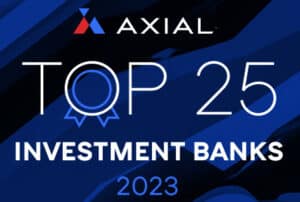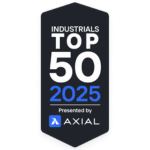
Stuff rolls downhill. I use this phrase when explaining to clients how analyzing the values of larger public and private companies in the marketplace can give them a relative sense for how their smaller business might be valued. But increasingly, we all need to be looking at how the impact of new entrants or new combinations may change valuations in the future. When we get a new client looking to exit their business, we try to give them our sense for the value of their business so we are aligned with their expectations. The way we do this is by looking at the publicly traded companies in their space and then finding recent, comparable sales. We look at the public companies that are doing what the client does, but on a much larger scale.
For example, with auto parts manufacturing clients, we look at 40 public companies, such as Borg Warner, Lear Corp. Tenneco and Dana Corp. We look at low and high EBITDA multiples, but in particular, we focus on the mean and median midpoints, which are hovering now at around eight times to 10 times EBITDA. For tire and service retail clients, we start with Monro Inc., which is the most visible publicly traded company in this space. As of this writing, it traded at 15.3 times EBITDA. That’s a pretty good upper end for all smaller retail tire dealers to be measuring their lower value against.
Now besides Monro, there’s not much else to compare against, except for what we know of in our own transactions or hear in the market. We assume that some of these recent big deals — like when Mavis Tire, with more than 1,000 stores, traded hands to a new private equity buyer — were either in that same range, but possibly higher. We heard that when Driven Brands last traded hands a few years back, it might have been at a 12 times EBITDA multiple, so I tend to still use that as the low end for the large companies. Anyway, for large companies in tire retail and service, let’s say the range is 12 times to 15 times-plus EBITDA and more.
For automotive e-commerce clients, we look at 50 public companies, like 1-800-Flowers.com, Amazon, eBay, CarParts.com, Parts ID and others. These 50 companies have mean and median values of 27 times to 34 times EBITDA. All of this helps owners understand where they may fit in the value range. If you are a $12 million auto exhaust manufacturer, you’re going to trade for about a three times to five times EBITDA multiple because the median public companies are only eight times to 10 times EBITDA.
If you are a six-store chain of tire stores, you’re going to trade for maybe five times to seven times, depending on the appetite of the buyers and your level of profitability, among other things.
And if you are an automotive e-commerce company with $60 million revenue and a good brand, you might be looking at a nine times to 10 times EBITDA or a higher, double-digit multiple.
Now paying attention to how public and large private companies’ valuations change over time will also let you know what the trend is within your category of business. For example, in May 2016, Monro was trading at the same multiple it is today — 15 times EBITDA. Knowing this signals that valuations overall have remained steady and strong for retail tire dealers. Had they been 12 times EBITDA in 2016, one would say valuations have been growing.
But how do you read the tea leaves about future valuations? Look at what else the information above is telling us. Old-economy auto parts manufacturers with capital intensive, internal combustion engine-focused (ICE), two-step and three-step distribution businesses are valued pretty low. Tire and auto service retailers that install some of these parts — but control the customer experience in their physical stores — are valued much better. But virtual, internet-based companies that sell direct to the consumer are valued the highest. It’s like looking at the past, the present and the future right there. And that’s how new business models can be valued much higher than older public companies in the same industry. The market is predicting that things are going in a particular direction. That’s why Tesla is seemingly worth more than all of the Detroit auto companies combined. That’s why Warby Parker, the online eyewear company, trades at 10 times revenue – not EBITDA. With sales of $500 million, Warby Parker is worth $5 billion. And that’s why Allbirds, the online shoe company, trades at nine times revenue. Allbirds is worth $2 billion on sales of $260 million.
While Tesla is obviously about the shift from ICE to electric vehicles, it’s also partly about selling direct to the consumer (D2C). The market is saying brands that operate as retailers — controlling both the customer experience and the customer relationship — trade at much higher values than other companies. But more than that, these companies have the right sort of positive customer experiences that build brand reputations, drive customer loyalty and retention, reduce operating or marketing expenses over time and will eventually result in higher margins. The market also is expecting that these brands will eventually capture a higher share of a customer’s lifetime purchases and become more dominant channels than existing competitors.
My colleague, Giorgio Andonian, picked up on this trend in recent transactions he led for us in the auto parts and accessories businesses. Neither of the clients involved in these deals actually manufacture their products, which are mostly produced overseas, although they are very involved with product design and development. In both cases, every product was sold directly to the consumer through the client’s website or call centers, with our client’s brand on them.
Common denominators are that both clients dominate their niches with high brand awareness, both had great profit and EBITDA margins, both controlled 100% of the customer’s buying experience and both fetched very high valuations at closing. D2C business models are consistently valued higher than traditional, unbranded, two-step or three-step distribution models. According to private equity buyers, the “margin profile” is higher in D2C. (By the way, “margin profile” is a new term going around that means the same thing as “profit margins.” It’s just an attempt by people who invest other people’s money for a living to make what they do seem more scientific and sophisticated). These D2C companies cut out distributors and wholesalers and sell directly to consumers, mostly online. Increasingly, you’re seeing these companies become omnichannel retailers. For example, Warby Parker and Tesla have physical stores and showrooms, in addition to their online presence.
So what does this D2C valuation trend mean for people in the tire business? Well, commercial tire dealers need to resolve the issue of who controls the customer. Commercial tire dealers have a direct impact on their national account customers’ experiences, but with these arrangements, the tire manufacturers set the prices and determine the margins. I believe the recipe for improved profitability for many commercial tire dealers needs to start with sorting this out. For tire wholesalers, not all tire brands are going to go direct to the consumer. Keep adding value to your customers with faster deliveries, fuller assortments and support programs and seek out profitable niches.
I’d like to take a moment here and speak directly to the marginally profitable tire wholesalers reading this with net EBITDA margins consistently below 2% or thereabouts. If you’re in this position, it’s time to get out. Your customers are not rewarding you with superior profits and your pricing is messing up the market for everyone else. Here’s what I suggest you do.
Low-profit tire wholesale businesses sell for net asset value. Sell your assets to a competitor. (This is likely a non-taxable event.) Pay off your debt; lease any distribution centers you own at fair market rent since you’re likely below market and can live off that rent; and invest the proceeds in a diversified portfolio in the stock market. The S&P 500 Index has averaged 10.7% compounded annual returns for the last 30 years, through good and bad years. If after you sell everything off, you have $2.5 million, that will be worth $7 million in 10 years if you don’t touch it. If you have $5 million, that will be worth $13.8 million in 10 years. You are much better off liquidating those assets and earning a higher return elsewhere. For retail tire dealers, Discount Tire is showing the way forward with its recent acquisition of Tire Rack. Both Discount Tire and Tire Rack engender great customer loyalty. Customers love them.
I was in Southern California visiting my cousin, a former judge who is now a practicing attorney again, when the Tire Rack deal was announced. It turns out, my cousin has always shopped at Tire Rack. And now he lives in one of the 24 metro regions that Tire Rack’s mobile installation service operates in. He loves the information the Tire Rack website provides and their multi-brand assortment, now coupled with the convenience of having someone come to his house and install those tires in his driveway. With its 1,100-plus-and-growing retail store footprint and now with the acquisition of Tire Rack, Discount Tire is the largest omnichannel tire retailer out there. The main responsibility of publicly traded tire companies like Goodyear Tire & Rubber Co., Michelin Group and Bridgestone Corp. is to enhance the stock value for their shareholders. They are looking at the valuations of some of these D2C businesses and are learning from them. It should be no surprise that Goodyear has spent a lot of resources on its online presence since 2015. Bridgestone — with its Firestone Direct mobile tire installation program and its recent 10% minority investment in Wrench, the mobile auto service company — certainly points to a D2C future in which Bridgestone controls more of the customer experience, much like Tire Rack does today. Bridgestone’s margins should improve and if this also enhances customer loyalty, so should their stock price.
If you’ve been around the tire business for any period of time, you’ve seen these mobile installation businesses come and go. I’ve always been a skeptic — until now. I think they’re going to stick.












